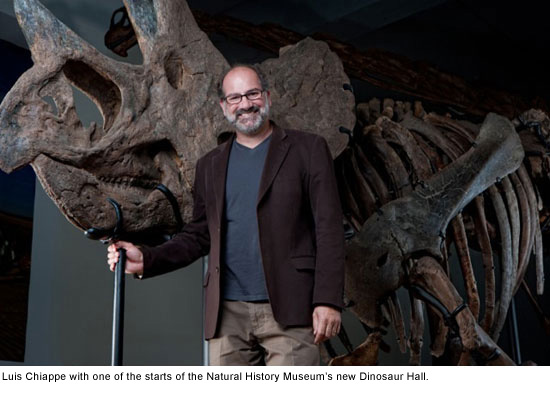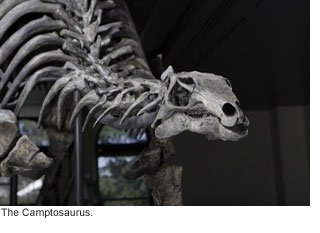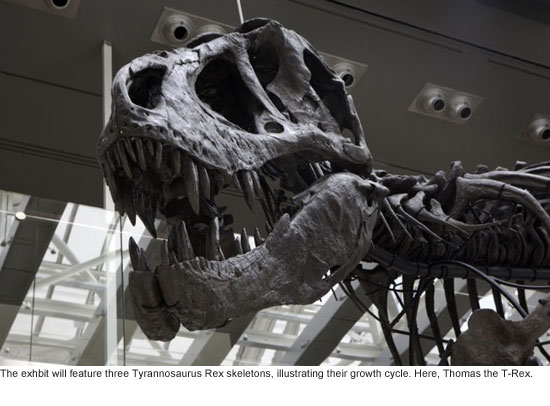Dinosaurs roar back to life at exhibit
July 7, 2011
 Their body temperatures were almost the same as a human’s. Some had plumage and the ability to make noises. Some had footprints and tail shapes about which we were wrong until recently.
Their body temperatures were almost the same as a human’s. Some had plumage and the ability to make noises. Some had footprints and tail shapes about which we were wrong until recently.
We’re fairly sure about what killed them (fallout from a meteor crash) and what they evolved into. (Hint: It has feathers). But much of their 230 million years on the planet remains a mystery.
You could fill an encyclopedia with what scientists are still discovering about dinosaurs. But for the past several years, Luis Chiappe, director of the Dinosaur Institute at the Los Angeles County Natural History Museum, has had something even bigger in mind.
This month, a newly renovated, 14,000-square-foot Dinosaur Hall will open, doubling the dinosaur display space at the museum. The permanent exhibition, which opens to members July 10 and to the general public July 16, will feature some 20 new major mountings from the museum’s expanded collection—from an extraordinary trio of young Tyrannosaurus rex skeletons to the smallest dinosaur ever discovered in North America. It also will reflect the ways in which technology has revolutionized paleontological research.
“This is not a chronological journey through time, and this is not setting animals in dioramas,” says Chiappe, who led much of the fieldwork responsible for the exhibit and curated it as an invitation to visitors to regard the towering fossils with a scientific eye.
“This is, ‘How do we know what we know? How do we reconstruct the life and, in the end, the death of these animals?’ This is an up-to-date, state-of-the-art understanding of the lives of the dinosaurs.”
In other words, this is not your father’s dinosaur museum. The new Dinosaur Hall will fill two rooms with nearly 300 specimens collected over nearly a century, with at least a third of the major pieces never before having been shown to the general public.
Displays will include background on how technological advances such as CT scans and particle accelerators have, for example, helped scientists understand the internal organs of dinosaurs and deduce the original colors of their skin and feathers. Many of the pieces have yielded important new discoveries and resulted in published research.
“Some amazing things were unearthed in the course of doing this hall,” says John A. Long, vice president of research and collections at the museum, which operates not just as a showcase, but also as a major research institution.
And, Long adds, because of improvements in conservation methods, “you can see the bones better—they’re better prepared.”
Among the showpieces will be the dramatic grouping of young T. rex skeletons—baby, early adolescent and teenager—that, taken together, make up the world’s only depiction of the famous carnivore’s growth pattern.
Also featured will be one of the most anatomically accurate depictions to date of the massive Triceratops, culled from several finds that included a completely articulated set of front leg, or “arm”, bones—a rarity that has contributed a fresh understanding of how the massive creature walked and lived.
Both the Triceratops bones and the oldest T. rex—a gangly, 33½-foot-tall teenager nicknamed “Thomas” that boasts one of the most complete skeletons in existence—were collected by Chiappe and his crews during field work in Wyoming and Montana. But the displays also include the museum’s very first specimen (a lower jaw from a Canadian duck-billed dinosaur that was collected in 1919), and a number of significant finds collected for the museum by the late Harley Garbani, a self-taught fossil hunter from Hemet who died at 88 in April.
”He toured the galleries a couple of months ago, but it would have been wonderful if he could have been around for the opening,” Chiappe says wistfully.
 Additionally, there are killer sea reptiles known as Mosasaurs, who, upon closer inspection by Chiappe and his colleagues were recently found to have had flukes, not long, tapering tails as scientists once imagined. Chiappe and Long say the information was there all along, but no one noticed it because the fossils had been in storage since they were found in Kansas and acquired during the 1960s.
Additionally, there are killer sea reptiles known as Mosasaurs, who, upon closer inspection by Chiappe and his colleagues were recently found to have had flukes, not long, tapering tails as scientists once imagined. Chiappe and Long say the information was there all along, but no one noticed it because the fossils had been in storage since they were found in Kansas and acquired during the 1960s.
“We have one of the best specimens in the world,” Long says, “and it had been locked up until we dusted it off and prepared it for this gallery. In doing so, we found skin and pigments and bronchial tubes and a wealth of new information, including a big tail fluke, like a tuna or a shark, that changes what we know about the way they swam and hunted.” (Stay tuned for further developments on this front. Museum sources say another blockbuster announcement about this part of the exhibit could come within the next few weeks.)
The Dinosaur Hall is part of an ambitious plan to expand and modernize the Natural History Museum, which celebrates its centennial in 2013. A groundbreaking “Age of Mammals” exhibition opened last year; a new California history hall and several other permanent exhibitions, including a 63-foot-long fin whale specimen, are anticipated before the end of next year.
Chiappe, an internationally renowned paleontologist who was recruited 12 years ago from New York’s American Museum of Natural History to supervise Los Angeles’ dinosaur collection, says the permanent exhibit had been under consideration almost from the moment of his arrival, “but we’ve worked intensively in the last five or six years.”
A native of Argentina, Chiappe says he grew up as “a city boy” in Buenos Aires, but learned from his grandfather to love the outdoors.
“We’d go hunting and fishing,” he recalls. “For a while, I wanted to be a biologist, and I went to university with that in mind. But then I met a classmate who was into paleontology, and we started going out on weekends, collecting Ice Age fossils, like saber-toothed cats and mastodons, amazing animals that don’t exist anymore. I thought it was incredibly cool.”
Chiappe has since done extensive fieldwork and research, particularly into the evolutionary links between dinosaurs and their modern counterparts, birds. The Dinosaur Hall also will address those connections.
“We will have a taxidermy pelican in a glass case, and a swan, an ostrich and a pelican skeleton,” he says. We will have a mural featuring emus, and we’ll talk about hummingbirds as dinosaurs—the idea that dinosaurs are in your backyard, and if you want to see one today, they’re right outside their window. You only need to look.”
Chiappe’s favorite displays? Well, he says, his favorite dinosaur is T. rex, and his 4 1/2-year-old son’s is Triceratops. But No. 1 on his Dinosaur Hall hit parade is the “Fossil Wall,” a 43-foot display case with nearly 100 specimens, from dinosaur bones and droppings to dinosaur eggs and skin.
“It’s beautiful from an aesthetic point of view,” he says, “and it expresses the wealth of our collection—it’s really an art installation using dinosaur body parts.”
What does he hope the public will glean from the museum’s scientific take on his favorite subject?
“I’d like people to understand that they were living animals,” he says. “We know them as skeletons. We see their bones in museums. But they were alive once. They suffered and had illnesses and diseases, and found mates and reproduced and did everything we associate with living animals, whether they are our pets or ourselves.”
Long, a fellow paleontologist who came to the museum two years ago from Australia, calls the new Dinosaur Hall “one of the most exciting dinosaur exhibits in the world,” and says it has been “a dream come true to be part of a team presenting a gallery like this.”
But, he adds, “this really is Luis’ baby.”
“It’s obviously once in a lifetime that a curator is essentially setting the course on the steering wheel for a major exhibit like this,” agrees Chiappe. “I know I won’t have another opportunity like this.”
Posted 7/7/11















 405 bridge work causes a stink
405 bridge work causes a stink